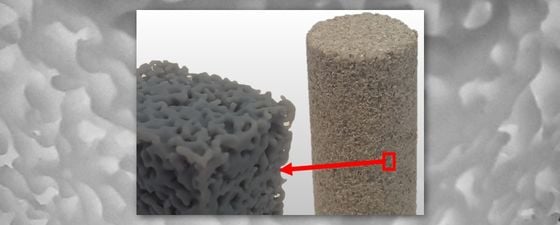Understanding the petrophysics of a reservoir rock, defined as the study of the physical and chemical properties of rocks and their contained fluids, has long been an integral part of efficient and successful production of oil and gas in the petroleum industry. To fully understand the petrophysical properties of reservoir rocks, pore-scale imaging and 3D digital modelling are used as routine methods to investigate rock characteristics that influence flow. The analytical process often requires multiple samples and some of the processes can destroy the original sample.
“Making copies of the natural rocks using 3D printing techniques offers the petroleum industry an additional way to analyse core samples,” says Sergey Ishutov, PhD candidate, and Franek Hasiuk, Assistant Professor in the Department of Geological and Atmospheric Sciences at Iowa State University. “It is important to preserve limited or even rare core samples from destructive analysis. Analysing a ‘copy’ will allow different tests to be performed on an identical pore network. These models can be printed in multiple materials to control for geometrical effects on properties from the pore network. In addition, when flow properties are calculated on a digital pore network model with computational methods, we can 3D print that digital pore network and test it in the lab.”
3D Printing
 3D printing has been used to create human tissue, prosthetics, car parts, guns and much, much more.3D printing got started in the 1980s with what was called Rapid Prototyping technologies. The original process was conceived as a fast and cost-effective method for creating prototypes for product development. The first patent was issued in 1986 to Charles Hull for a stereolithography apparatus. Mr. Hull went on to co-found 3D Systems Corporation, one of the largest in the 3D printing business today. In the early 1990s, researchers at Massachusetts Institute of Technology (MIT) developed their trademarked 3DP and MIT remains an innovative leader in the industry.
3D printing has been used to create human tissue, prosthetics, car parts, guns and much, much more.3D printing got started in the 1980s with what was called Rapid Prototyping technologies. The original process was conceived as a fast and cost-effective method for creating prototypes for product development. The first patent was issued in 1986 to Charles Hull for a stereolithography apparatus. Mr. Hull went on to co-found 3D Systems Corporation, one of the largest in the 3D printing business today. In the early 1990s, researchers at Massachusetts Institute of Technology (MIT) developed their trademarked 3DP and MIT remains an innovative leader in the industry.
Advance ahead 30 years, and 3D printing has become commercially available in just about all sectors of the economy. It has become much cheaper, faster, uses a wide variety of materials and is available in many sizes and capabilities. Amazingly, 3D printing can now create human tissue, prosthetics, car parts, rocket parts, guns, food, and the list goes on and on.
Making the Copy
Natural rocks contain a variety of different grain sizes, types, and shapes cemented together. Among the grains and cement, a typical reservoir rock will also have pore space containing fluids and connections (pore throats) through which the fluids can be extracted. “To manufacture porosity models of a sandstone, we use computed tomography (CT) scans and petrographic data from the natural sample,” say Sergey and Franek. “The first step is an acquisition of two-dimensional (2D) CT images that are subsequently reconstructed into a 3D digital rock model composed of voxels (a ‘volume element’ similar to a pixel in 2D images), which are assigned a grayscale value based on x-ray attenuation during CT. The second step is to segment the volume into grains and pores. The third step is to 3D print the surface representing the boundary between the grains and pores. The materials we can print include plastic as well as powder-based gypsum and silica. The fourth step in the workflow, where it gets fun, is a comparison of petrophysical properties of natural rocks with their 3D printed copies (for example, via mercury porosimetry).
“3D printing offers a novel and nondestructive method of petrophysical rock analysis (preserving original rock samples), using destructive lab techniques to obtain rock properties that can then be compared directly with measurements from original rock samples, estimated from computational methods, or culled from the literature data. Repeatability in manufacturing, the flexibility in up-scaling and downscaling digital models, and variability of 3D printing materials are the main directions where 3D printing can be advanced with a high potential to improve our ability to copy natural reservoir rocks.”






